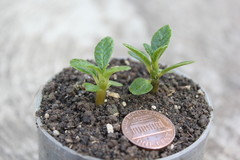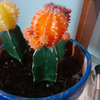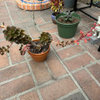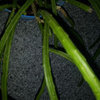Winter watering (and Dorstenia gigas)
My normal practice is to use a very porous soil (pumice, Turface, and granite grit) that allows me to water thoroughly each time until water runs out the bottom. I feel good about this because excess salts get flushed out at every watering, and I don't have to worry about dry pockets of soil. I try to wait until the pot feels completely dry before watering. Most plants tolerate this very well, but I did lose a Pseudolithos cubiformis and a Dorstenia gigas to rot this winter. Now I'm wondering if some of these more sensitive plants should be watered lightly, or if I should continue to water them heavily, but even less frequently.
How do you guys water during winter? Heavily? Lightly? Frequently? Infrequently?
Also, what's up with Dorstenia gigas? I try to be very careful about watering, but this is the second one I've lost to rot. I thought these were supposed to be relatively tolerant, and even appreciative, of water.
Comments (14)
- 13 years ago
I'd give those two a wide berth in winter, especially if you can't give them 75-80F temps consistently along with your watering. Only sips of water now for those two, IME (although I've never actually grown D.g.).
And Dorstenias are tolerant/appreciative/needing of water, but now's not the time to apply that, only in the summer, unless, again, you can duplicate Soqotran weather.
Watering - me, twice a month in winter, and the growing plants get a drenching, the dormant plants get but a sip.
0 - 13 years ago
Agreed. All my Dorstenia (just foetida and crispa, don't grow gigas) are running very dry right down - when I do water them it is a spray, not a drench. They are pretty bare at this time of year for me, too...
I may water my Dorstenia a little more frequently than my other dormant plants (bursera, commiphora, adansonia, etc. which I water about once a month until March) but not much more frequently...and definitely, as I said, with a spray. They should never sit with wet soil at this time of year for more than a day or so, IMO.
I do water my P. cubi about once a week or so, but it is in a relatively warm location (70F daytime) with very bright light. Since it gets pretty cool at night (down to low 50s) I often place it on a seed heat mat at night. That said, it is not really growing very much right now, though my P. migiurtinis has grown significantly during the same time period with the same treatment.
T
0 Related Professionals
Accokeek Landscape Architects & Landscape Designers · Birmingham Landscape Architects & Landscape Designers · Harrison Landscape Architects & Landscape Designers · Horsham Landscape Architects & Landscape Designers · Choctaw Landscape Contractors · Pleasant Prairie Landscape Contractors · Richmond Landscape Contractors · Soddy Daisy Landscape Contractors · Brownsville General Contractors · Hagerstown General Contractors · Olney General Contractors · Riverdale General Contractors · Welleby Park General Contractors · Matteson Carpenters · Dayton Decks, Patios & Outdoor Enclosurespenfold2
Original Author13 years agoThanks, that confirms a lot of what I was thinking. My greenhouse does get to 75-85F during the day (60F at night), but maybe the days are still too short for many plants to break dormancy. I've been watering my remaining D. gigas more lightly, but I think I'll start watering some of my other dormant plants more lightly as well. Saturated soil may be too much for some dormant plants, even if they do dry out in between. Hopefully things will start growing soon.
Tom, I thought my P. cubiformis was pretty tolerant of water being as it was in a warm greenhouse under a bank of T5 HO fluorescents, but it rotted from the bottom up. I was pretty upset about that one since it had grown considerably since I got it. I don't imagine they need much water this time of year, so just be careful with it.
0- 13 years ago
Pen -
So I can learn from your misfortune (sorry!) could you estimate how frequently you were watering your cubi in the conditions you describe? (which are definitely warmer than mine!) What were the external signs that it was, in fact, starting to rot?
I have heard that cubi's are tricky - too much water at the wrong time, they can rot - and, too little water at the wrong time, they can rot...
I think migiurtinus is supposed to be a bit more durable.
Thanks.
T
0 penfold2
Original Author13 years agoI was probably watering heavily once or twice a week. I was using the pumice, Turface, granite mixture I mentioned above, which seemed to dry out very quickly. Upon unpotting it, I found the center of the pot still held some moisture, and that was apparently enough to do it in. Temperatures were 75 day, 60 night at the time. I had no idea it was rotting until I saw a slight discoloration at the base. A little wiggle and it popped right off. I now gently wiggle a lot of my plants to check for root rot. When I get another (which I definitely will), I will make sure it gets bone dry top to bottom in between waterings during winter. And I will water lightly instead of drenching the soil.
Good luck!
0- 13 years ago
Was your Dorstenia in leaf? I water my 2 gigas about weekly this time of year if they have leaves. They are in my living room near a windowsill at room temp. One is actively growing, the other is leafless.
Psuedolithos seem to need hot temps day and night for good growth. At other times, unless they feel very soft, an occasional light watering should suffice. I suspect they are also prone to rot if they get injured, much like Pachypodium. I once had a big, healthy Pseudolithos that was knocked over in its pot (probably by a squirrel) and was completely unearthed. Despite gentle care, it rotted after a few months for no apparent reason.
x
0 penfold2
Original Author13 years agoR, I lightly fertilize at every watering. When I water lightly, I'll stick to RO water so as not to accumulate salts, but heavy waterings always get a bit of fertilizer. I'd probably do this with any soil, as I can't imagine peat and pine bark offering much nutrition. In fact, from what I've read, they rob the soil of nitrogen due to their high carbon:nitrogen ratio.
X, my Dorstenia had a few tiny leaves, but was pretty much dormant. I didn't think they should be allowed to dry out excessively during winter, but maybe they just need a light watering, so as not to saturate the soil. When my remaining Dorstenia begins growing, I will start watering heavily again.
I think I just need to start practicing light watering on many of my dormant plants (and maybe less frequently as well). I've always been worried about losing roots to dry pockets of soil that never receive water, but some plants just don't seem to tolerate saturated soil when dormant. At least losing an occasional plant teaches me to care for the remaining ones better.
0- 13 years ago
An unhappy D.gigas can rot in hours-almost before your eyes. A happy D.gigas can take all the winter rain the bay area has in winter-about 14-18" in it's pot and do fine. I suspect there is a certain soil temp level that is a threshold. In a pot,our winter sunshine is just enough warmth..in ground or too much shade,they rot. And no doubt you could mix in a need for high light-even leafless,the trunk shows green light needy cells. They can be touchy.
0 - 13 years ago
Sorry in advance everyone... I do not grow Gigas... But I do grow Foetida and Crispa. I have great luck with these two and find them relatively simple. I have these 2 planted in MG Cactus soil mixed with sand ;) spare me please. I take these 2 outside in the summer and bring them inside to my computer room in the winter. They retain their leaves all year and stay in flower all year. In the summer they get whatever rain falls, and supplemental waterings when other nearby plants are in need. I have never noticed these plants to get pouty in dry growing situations. I water them about monthly in the winter and when I water them I may use an 8 oz cup. My computer room has the least humidity in my home. 1 Heat vent(wife keeps heat on 73), 2 computers running always, 2 printers, 6 monitors, and various other heat producing electronics. This room also has 2 south facing windows.
I do not know if this is the proper way to grow these plants... But I can say that it has been working for me for several years now.
BTW - In my research I found that Gigas is the most sought after Dorstenia maybe after Lavrani at this time. Dorstenia Gigas fetchs a higher price because it is know to be hard to propagate successfully and doesn't flower/seed as frequently as other Dorstenias.
-David
0 - 6 years ago
Hi, I would like to share my experience with watering. First of all, what makes you think that water must go thoroughly down while watering? No it doesn’t not and it is better to water lightly so top roots will suck the water and bottom ones will carry on searching for more water :) and getting bigger. I can do it because I live in Barbados but I still prefer to just mist my plants on daily basis instead of watering them so hard. I plant Dorstenia Gigas in soil, just poor soil with some tiny lime stones, all from my garden. This soil drys in 6 hours and this tells me that I will never overwater my plants. It is all about knowing your environment and your soil but to be true that it is all about knowing of right portion of water and your plant environment! Study your watering and see how fast your soil drys out. I have around 30C+ every day so I do not need to worry about drying out my soil. Please see attached little Dorstenia gigas in organic soil...It’s all about understanding that cacti and succulents love water but love to sit in dry as well :)
 0
0 - 6 years ago
Forgot to add that apparently Dorstenia gigas should be kept warm and moist during winter times as winter in Socotra Island is wet and hot ! But if it is grown in different climate it may act a bit differentially, what’s your location ?
0 - 6 years ago
I'm in a Mediterranean type climate- also maritime influenced so summers are never hot. Mild with the occasional heatwave.
I see in 2011 I noted that mine when I tried to plant in in ground- rotted very fast in cold wet clay soils. The same plant has never rotted at all in the very same yard in a pot. Same cold,wet,frost. Its seen at least 31f..nothing set it back. Only my planting in the ground and of course the glacial growth in the San Francisco bay area summers.
Even this winter record wet...no problem. Its almost identical to the problems I have had with Aloe polyphylla. Rot in ground,thrive in a pot. Its all about the rooting media.
0 - 6 years ago
or maybe ground holds water longer and if they grown in pods the soil will dry out quicker...
0











land3499